GCSE Tutoring Programme
"Our chosen students improved 1.19 of a grade on average - 0.45 more than those who didn't have the tutoring."
In order to access this I need to be confident with:
Place value Arithmetic Simplifying fractions Mixed numbers and improper fractionsThis topic is relevant for:

Fractions To Percentages
Here we will learn about converting fractions to percentages.
There are also fractions to percentages worksheets based on Edexcel, AQA and OCR exam questions, along with further guidance on where to go next if you’re still stuck.
What is converting fractions to percentages?
Converting fractions to percentages is representing the fraction as a percentage without changing its value.
E.g.
What is converting fractions to percentages?
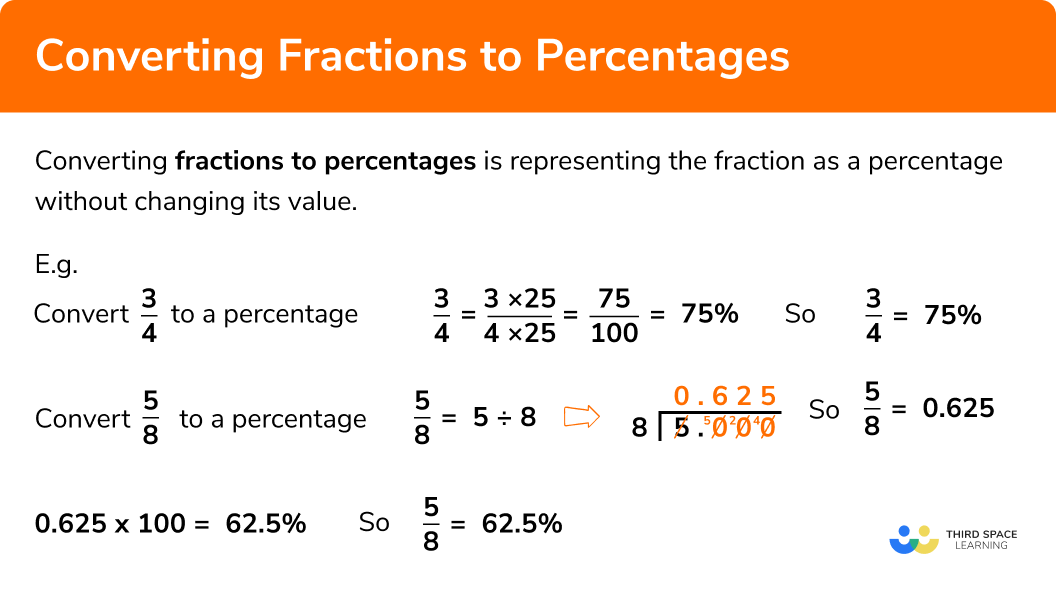
How to convert fractions to percentages
In order to convert from a fraction to a percentage there are two methods which are used depending on whether the denominator is a factor or a multiple of
- Determine if the denominator is a factor or multiple of
100
If it is follow these steps:
2Convert the fraction so the denominator is
3Write the numerator as a percentage because it is now ‘out of
4Clearly state the answer showing the ‘fraction’ = ‘percentage’
If the denominator is not a factor or multiple of
2Divide the numerator by the denominator
3Multiply by
4Clearly state the answer showing the ‘fraction’ = ‘percentage’
Explain how to convert fractions to percentages
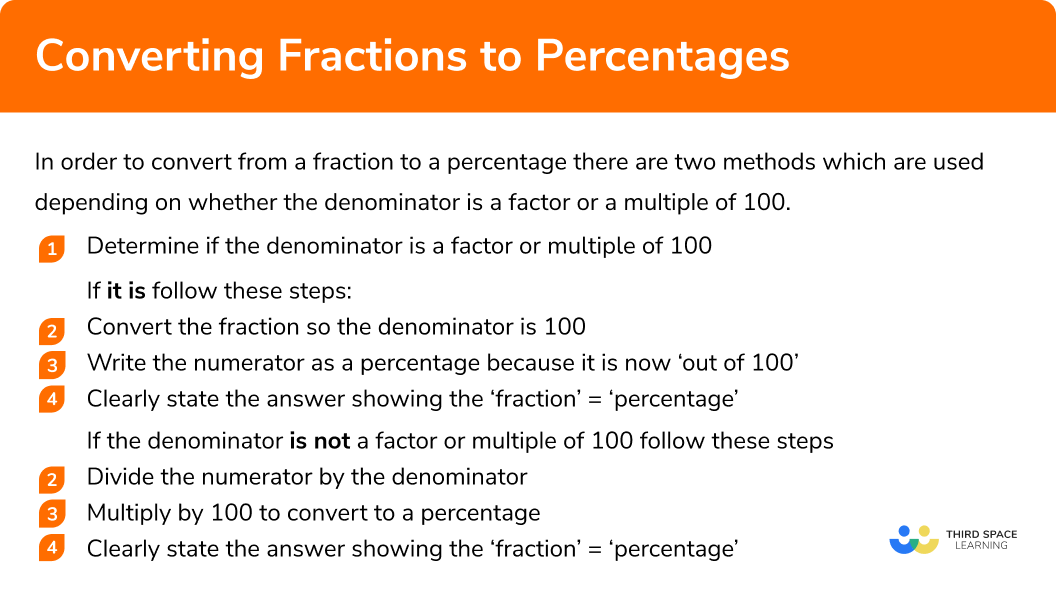
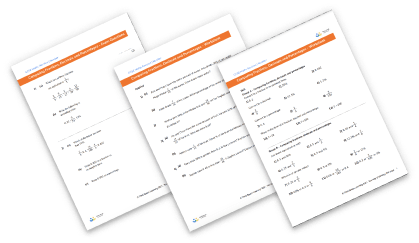
Fractions to percentages worksheet

Get your free fractions to percentages worksheet of 20+ questions and answers. Includes reasoning and applied questions.
DOWNLOAD FREE
Fractions to percentages worksheet

Get your free fractions to percentages worksheet of 20+ questions and answers. Includes reasoning and applied questions.
DOWNLOAD FREEConverting fractions to percentages examples
Example 1: converting a simple fraction to a percentage, where the denominator is a factor of 100
Convert \frac{3}{4} to a percentage
- See if the denominator is a factor or multiple of
100
2 Convert the fraction so the denominator is
3Write the numerator as a percentage
\frac{75}{100}=75\% \quad \quad because
4Clearly state the answer showing the ‘fraction’ = ‘percentage’
Example 2: converting a fraction to a percentage, where the denominator is a multiple of 100
Convert \frac{60}{200} to a percentage
See if the denominator is a factor or multiple of 100
Convert the fraction so the denominator is 100
Because we are converting to a percentage we only need to simplify the fraction so that the denominator is
Write the numerator as a percentage
\frac{30}{100}=30\% \quad \quad because
Clearly state the answer showing the ‘fraction’ = ‘percentage’
Example 3: converting a fraction to a percentage, where the denominator is not a factor/multiple of 100
Convert \frac{5}{8} to a percentage
Determine if the denominator is a factor or multiple of 100
Divide the numerator by the denominator
Therefore,
Multiply by 100 to convert to a percentage
Clearly state the answer showing the ‘fraction’ = ‘percentage’
Example 4: converting a fraction to a percentage, where the denominator is not a factor/multiple of 100 – involving a recurring decimal
Convert \frac{2}{9} to a percentage
Determine if the denominator is a factor or multiple of 100
Divide the numerator by the denominator
Therefore,
Multiply by 100 to convert to a percentage
Clearly state the answer showing the ‘fraction’ = ‘percentage’
Example 5: converting an improper fraction to a percentage
Convert \frac{25}{20} to a percentage
See if the denominator is a factor or multiple of 100
Convert the fraction so the denominator is 100
Write the numerator as a percentage
\frac{125}{100}=125\% \quad \quad because
Clearly state the answer showing the ‘fraction’ = ‘percentage’
Example 6: converting a mixed number to a percentage
Convert 4\frac{5}{16} to a percentage
Added step- convert to an improper fraction first:
Determine if the denominator is a factor or multiple of 100
Divide the numerator by the denominator
Therefore
Multiply by 100 to convert to a percentage
Clearly state the answer showing the ‘fraction’ = ‘percentage’
Calculator skills
If you are allowed to use a calculator you can perform the operation in one calculation.
E.g.
Convert \frac{25}{20} to a percentage
- Enter the fraction on the calculator and multiply by
100 - Press =
- This means 125\%
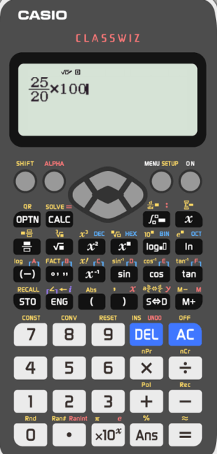
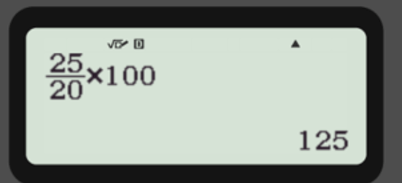
Common misconceptions
- Mistakes with written division
Often mistakes are made when implementing a form of written division. For example a common mistake with the ‘bus stop’ method is mixing up the number being divided (dividend) by the number you are dividing by (divisor).
The numerator is the dividend and therefore goes inside the ‘bus stop’.
- Not multiplying by
100 to make a percentage
The percent sign means the number is given out of
E.g
- Not noticing a recurring decimal
Sometimes a recurring decimal is not immediately obvious. For example
Therefore
Related lessons
Fractions to percentages is part of our series of lessons to support revision on comparing fractions, decimals and percentages. You may find it helpful to start with the main comparing fractions, decimals and percentages lesson for a summary of what to expect, or use the step by step guides below for further detail on individual topics. Other lessons in this series include:
Practice converting fractions to percentages questions
1. Convert \frac{1}{10} to a percentage




2. Convert \frac{4}{10} to a percentage




3. Convert \frac{11}{10} to a percentage




4. Convert \frac{6}{1000} to a percentage




5. Convert \frac{601}{20} to a percentage




6. Convert \frac{15}{16} to a percentage




Converting fractions to percentages GCSE questions
1. Convert each of the following fractions to percentages
a) \frac{9}{10}
b) \frac{1}{4}
c) \frac{9}{100}
d) \frac{9}{1000}
e) \frac{99}{10}
(5 Marks)
a) 90\%
(1)
b) 25\%
(1)
c) 9\%
(1)
d) 0.9\%
(1)
e) 990\%
(1)
2. Convert each of the following fractions to percentages
a) \frac{16}{50}
b) \frac{7}{25}
c) \frac{4}{75}
(4 Marks)
a) 32\%
(1)
b) 28\%
(1)
c) 1 mark for correct method but not showing the recurring decimals e.g 5.3\%
(1)
5.33333…\% or 5.\dot{3}\%
(1)
3. Match the fractions to the percentage
\begin{aligned} &\frac{2}{5} \quad \quad \quad \quad \quad 75\% \\\\ &\frac{3}{4} \quad \quad \quad \quad \quad 120\% \\\\ &\frac{6}{5} \quad \quad \quad \quad \quad 40\% \\\\ &\frac{26}{10} \quad \quad \quad \quad \quad 3\% \\\\ &\frac{3}{100} \quad \quad \quad \quad 260\% \end{aligned}
(5 Marks)
(1)
\frac{3}{4}=75\%
(1)
\frac{6}{5}=120\%
(1)
\frac{26}{10}=260\%
(1)
\frac{3}{100}=3\%
(1)
4. Represent \frac{113}{125} as a percentage.
(2 Marks)
(1)
0.904\times100=90.4
90.4\%
(1)
Learning checklist
You have now learned how to:
-
Convert a fraction to a percentage
The next lessons are
Still stuck?
Prepare your KS4 students for maths GCSEs success with Third Space Learning. Weekly online one to one GCSE maths revision lessons delivered by expert maths tutors.

Find out more about our GCSE maths tuition programme.